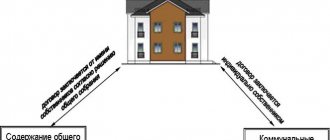The forms of management of apartment buildings are indicated in the Housing Code of the Russian Federation (Article 161). The main task of management activities is to create comfortable conditions for residents, guarantee the safety of joint material assets, organize the supply of utility resources, and care for local areas.
In addition to practical management skills, current laws, which are regularly changed and improved, must be taken into account. Therefore, owners and special companies operating on a commercial basis are allowed to manage houses.
Management of apartment buildings according to housing legislation
Housing legislation provides only 3 possible ways to manage any apartment building (Part 2 of Article 161 of the Housing Code of the Russian Federation).
So the forms of management include:
- Owner management;
- Owners' association (HOA), housing cooperative or any other PC;
- Managing organization.
At a general meeting of premises owners, methods for managing apartment buildings according to housing legislation are considered and a single one is selected.
In this case, the chosen method can also be changed based on a new decision of the meeting of owners. (Part 3 of Article 161 of the Housing Code of the Russian Federation).
You can read what a consumer cooperative is and how to create one here.
Direct management of apartment buildings
Direct management can be carried out in an apartment building with no more than 30 apartments.
In a given house, only one of the total number of owners, another person with powers of attorney, can immediately act on behalf of all the owners of the premises.
Management of apartment buildings according to the housing legislation of the Russian Federation.
What are the main advantages of this management format?
- Firstly, with direct management, premises owners will not have to spend funds to pay for the services of any management organization;
- Secondly, the owners themselves can choose contractors for home maintenance and repairs. The owners themselves decide for how long to hire contractors and when to refuse their services. Owners can also do maintenance on their own, saving considerable amounts.
- Thirdly, any of the owners himself enters into an agreement with resource supply organizations. Thanks to this, neighbors will not be forced to bear responsibility if one of the neighbors has payment arrears.
A little about the disadvantages of this control method:
- If there are a large number of apartments, the efficiency of the management may be significantly reduced; it is necessary to convene a meeting to vote on each of the housing issues.
- With direct management by the owners themselves, the opportunity to carry out major repairs of the house with money from the Reform Assistance Fund is lost.
In what order is the landscaping of the local area of an apartment building carried out and who is responsible for it - find out by following the link.
Management of apartment buildings through HOAs and residential complexes
It is possible to create an HOA and a residential complex in an apartment building if the idea is supported by more than half of the owners of one residential building or by the owners of several buildings.
The HOA is an association of owners and is a non-profit organization. A residential complex is an association of people/organizations for the construction of housing or for the management of a residential building (houses).
Since 2014, HOAs have been created in the form of a legal entity - a partnership of real estate owners, so there is no need to re-register the HOA in TSN since 2014.
The purpose of the organizations is to manage the common property of the house, its maintenance, provision of utilities, etc.
Scheme: Management of apartment buildings without the creation and through the creation of an HOA.
The main functions of associations in managing an apartment building:
- It is possible to provide some types of services on our own (cleaning the area, working with plumbing);
- When interacting with self-government bodies, it is possible to obtain funds from the budget for major repairs and training, if necessary. (Article 165 of the Housing Code);
- Carrying out some commercial activities.
Organizations can provide services to the home themselves or hire third parties. And if there is an agreement with the organization, obligations are monitored in accordance with the agreement.
When a homeowners association/residential complex enters into a management agreement for an apartment building with each of the participating owners, it is not mandatory to include the conditions in the organization’s charter.
The advantage of an HOA/residential complex is direct management of the house , provision of utilities, and identification of the interests of the owners.
Also, the HOA/residential complex can conduct commercial activities. Part of the funds spent on participation in the organization and management of the house will be taxed on preferential terms.
The disadvantage is the need to maintain a staff (one of the owners operating in the organization on a non-professional basis), and to spend funds on payments to staff members.
Managing organization in house management
A management organization is a commercial organization that provides house management services and has the appropriate license.
So, at a general meeting, the owners choose a specific management organization with which they plan to cooperate. Next, the terms of the contract, payment for repairs and maintenance of the house are agreed upon with her.
Each of the owners enters into an agreement with the management organization on the terms discussed at the general meeting. The management organization guarantees the provision of the agreed services for the agreed period of time.
The management agreement can be concluded for a period of 1 to 5 years. But at the same time, the owners have the opportunity to terminate the contract on the basis of the Civil Code of the Russian Federation.
More information on how to choose the right management company for a new building can be found here.
If the management organization provides services unsatisfactorily, it will necessarily bear responsibility in accordance with the law.
Owners may reconsider the form of house management if they realize that the management organization cannot perform the required tasks. Also, owners can begin cooperation with any other management organization by terminating the agreement with the previous one.
This decision is made at a general meeting of owners.
Disadvantages of managing an apartment building with the help of a management organization:
- The management organization is an organization that will most likely be aimed at obtaining maximum profit for the provision of services, so owners may be faced with inflated tariffs and a lack of interest in the honest management of the house for a reasonable fee.
- owners will not have the opportunity to directly control the services provided to them.
- If the owners themselves have not chosen the management method, the municipal authorities themselves will appoint a management organization. In this case, changing the management organization will not be easy.
Management benefits include:
- the opportunity to shift management and support concerns to the organization.
- presence of a representative in interaction with third parties.
How to change the management company and what is needed for this? Find out in this article.
Scheme: General meeting as the governing body of an apartment building.
Purpose of studying the issue
It is known that an apartment building is a complex complex; its maintenance requires solving many issues and knowledge of a serious amount of regulations; one has to constantly interact with citizens, organizations and authorities.
To this end, apartment owners must choose one of the proposed methods of managing their home. Let's look at how effective each of them is below. Much is determined by the activity of residents and their willingness to solve common problems.
Choosing a method for managing an apartment building (clause 4, part 2, article 44 of the RF Housing Code)
According to clause 4, part 2, art. 44 of the Housing Code of the Russian Federation, the choice of one of the methods of managing a house by the owners of the premises is made through a general meeting of the owners of the house (or several houses with a common territory).
So the general meeting is held in two forms:
- in person;
- in absentia.
, more than 50% of the votes of the total number of owners is sufficient to make a decision The voting decision is binding on all owners.
In-person voting
In a joint presence, that is, in person, the owners, having gathered at a certain time and in a specific place, discuss the issues put to vote.
Stages of in-person voting:
- The text of the proposed project is being prepared;
- The proposed project is put on the agenda, a meeting of owners is held, at which they are asked to approve the project;
- The owners approve or disapprove the proposed project (in accordance with the voting distribution scheme);
- The authorized person signs the document.
If any changes are made to the approved document, all owners must be notified of this, and they can either approve or disapprove the changes at a new meeting of voters.
Absentee voting form for owners of an apartment building
Absentee voting among owners is carried out by transferring decisions of owners on issues raised, set out in writing.
Absentee voting by the owners of an apartment building is possible when resolving any issues that would be within the competence of the general meeting.
You can read how to recognize a house as unsafe and subject to demolition, and in what order relocation from emergency housing is carried out in the publication at the link.
The survey can be conducted:
- When using a questionnaire, a record of voting results;
- Using a voting ballot.
Minutes of a meeting of residents of an apartment building: form and basic details
After the meeting and meeting at the first meeting of residents, the question of how exactly the house/houses with a common territory will be managed is decided. After the meeting and further voting, all voting data is entered into a special minutes of the residents’ meeting.
This protocol reflects some information about the residents themselves, indicates the form of voting, its results, and the initiative persons. The minutes must be completed and provided to residents 10 days after the meeting with voting.
Minutes of the meeting of residents of an apartment building - form to fill out:
Sample minutes of a meeting of residents of an apartment building.
Main provisions of the protocol:
- form and timing of voting; initiators;
- agenda;
- description of applications.
Filling features:
- Initially, a register of residents indicating the areas of their apartments (data can be obtained from developers, the owners themselves during a survey, and from utility workers).
- We will indicate the form of the meeting. The absentee form is usually more convenient, because in practice a much larger number of residents take part in it than with in-person voting.
- Next is the time for voting. It is important to choose a time that is convenient for most residents. Residents must be notified of the summons by signature.
- The place of delivery of decisions is indicated . Here it is convenient to list the apartment numbers of the initiative group of persons (owners, representatives by proxy and even management companies).
- Information about the total living area from the registration certificate of the house is indicated
- For convenience, you can prescribe a method for counting votes.
a sample protocol for a meeting of residents of an apartment building using this link.
To summarize, we note that our housing legislation gives owners the right to decide for themselves the most appropriate form of house management in each case.
You can get more information about the procedure for managing an apartment building with the help of an HOA in the following video lesson:
Resolution 416
This document is the most important regulatory act after the Housing Code. It expands the understanding of many provisions of the LC. Let's look at its structure:
- general provisions (control methods are listed);
- management standards;
- the procedure for creating a list of works and services for the maintenance of MKD;
- organization of emergency dispatch service;
- the procedure for transferring and generating technical documentation on MKD;
- procedure for terminating the activities of the management organization;
- procedure for disclosing information to homeowners' associations and specialized cooperatives.
It can be reasonably argued that the resolution of the Government of the Russian Federation on the management of apartment buildings covers many points in detail.
Creation of cooperatives
In addition to the HOA, co-owners have the right to entrust management to another legal entity, for example, a housing construction cooperative. However, unlike an HOA, a cooperative is initially created for the construction of a facility. Then the organization has the right to continue its existence. All its activities, as well as cooperatives similar to it, are similar to the work of an HOA. The reason is that the treatment of the common property of the owners of an apartment building is based on the same rules.
Thus, the methods of managing the owners of premises in an apartment building by organizing an association are reduced to the scheme established for the HOA.
There are cases of transformation of a cooperative into a HOA.
Supporting Resources
Management activities require the simultaneous performance of many functions. At the same time, changes are made to the legislation every day, new explanations are given to existing regulations, and judicial practice is analyzed. To simplify work with the increasing volume of information, for example, an electronic system for “managing an apartment building” has been created.
It allows you to systematize existing information and process it. Document templates are provided; all you have to do is fill them out.
Management Company
Its peculiarity is its commercial orientation. All other organizations have non-profit status and their activities are not aimed at making profit. Companies, on the contrary, are created precisely for this purpose. They are organized by both government authorities and private individuals.
The company provides a full range of services, at the same time, residents of the house have the right to choose a different option for cooperation. Thus, the following options are offered:
- the management company fully maintains the house;
- The contract is concluded with the HOA for the implementation of the list of works or services specified in the contract.
In the first case, no partnership is created; the co-owners have the right to choose an organization at a general meeting. If for some reason the meeting is not held, or citizens show reluctance to take part in choosing an organization, the municipal authorities appoint a competition. Next, they appoint a management company, which takes responsibility for managing the common property of the house.
The advantage of this method is the availability of resources that the HOA does not possess (equipment, personnel).






